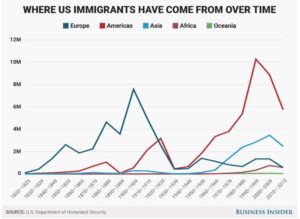Historic US migration trends underline current debate
President Donald Trump’s recent executive orders on immigration may have reignited public debate, but immigration has always been a controversial issue for Americans.
President Trump’s most controversial executive action saw him temporarily bar people from -Muslim-majority countries Iran, Iraq, Libya, Somalia, Sudan, and Yemen from entering the country for 90 days, and Syrians from entering until he decides otherwise.
Federal judges in several states declared the order unconstitutional, releasing hundreds of people who were stuck at US airports in limbo.
 But the White House continues to defend the action, insisting it was “not about religion” but about “protecting our own citizens and border.”
But the White House continues to defend the action, insisting it was “not about religion” but about “protecting our own citizens and border.”
Tens of thousands of people have protested against the move in cities and airports across the US, company executives came out against the order, and top Republicans have split with Trump and criticised his approach.
According to research by the Washington-based think tank the Pew Research Center carried out in 2016, a third of Americans said that immigrants are a “burden on our country because they take our jobs, housing and health care,” and 38 per cent think immigration should be decreased.
On the flip side, 59 per cent of Americans say immigrants “strengthen our country because of their hard work and talents” and either think immigration should stay as its present level or increase.
Today, immigrants make up 13.5 per cent of the US population — about the same proportion as it was in 1860, according to the Migration Policy Institute.
The overall number of immigrants coming to the US peaked between 2000 and 2005 at five million. It has been declining since then.
US immigrants were largely of European descent in the 1800s, and started coming from the Americas (largely Mexico) in the 1960s.
The sharp decrease in the 1920s is due to Congress passing the Exclusion Act, which set limits on the number of immigrants who could enter the US, based on a quota system of the percentage of nationalities already in the country.
Barely anyone from Asia could enter at all.
Congress revised the law in 1952, and immigration started to tick up again.
The Pew Research Center has created this fascinating interactive graphic show the countries from which immigrants moved to the US between 1850 and 2013:
Laurie Nowell
AMES Australia Senior Journalist












